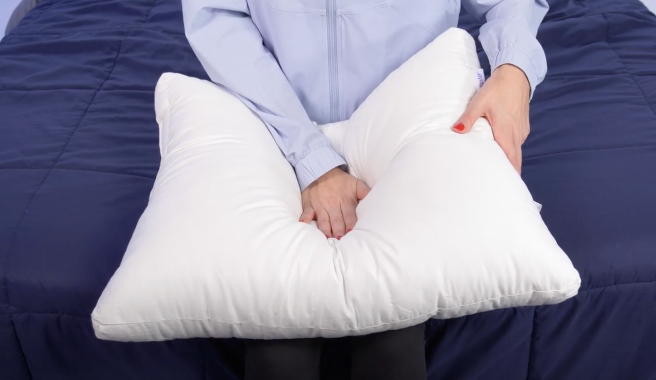Down vs. Feather Pillows
Disclosure: By clicking on the product links in this article, Mattress Nerd may receive a commission fee at no cost to you, the reader. Read full disclosure statement.
Not sure if down or feather pillows are best for you? Read on to learn more about the differences between these two common types of pillows, plus their pros and cons.
You may be unsure whether to choose a down or feather pillow—or you may be unsure what the difference between them is in the first place. While both types of pillows are made from feathers, they actually perform quite differently depending on your sleeping position and preferences.
What Are Down Pillows?
Down pillows (not to be confused with down alternative pillows) are a kind of feather pillow, made from the softest chest and belly feathers of geese and ducks. However, unlike the standard feathers you might find on a bird’s wings, down is ultra insulating, soft, and quilless. So, this material is known for feeling weightless, puffy, and luxurious.
That said, many down pillows actually have a mixture of feather and down filling to keep them both firm and lofty. But, the general rule of thumb is that any pillow that’s more than 75% down is a down pillow.

Pros
- Softness—This is the main selling point of down. Compared to feathers, down pillows are super fluffy, light, and soft. If you’re looking for a luxurious pillow to sink your head into, down is the way to go.
- Easy care—Although it’s a luxury material, down is quite easy to care for and maintain. In fact, down is machine washable and dryable, although it’s recommended you dry on low heat and allow plenty of time for it to dry.
- Durable—Despite all its softness, down is much more durable than feather pillows and, due to the material’s rounded tufts, holds its shape for longer. So, while down is more costly, you’re definitely getting returns on your investment—in the form of years of good sleep.
Cons
- Price—All of the aforementioned benefits of down pillows do come at a cost. For example, an average Queen-size down pillow can cost as much as $80 to $200.
- Heat—This one’s subjective, depending on whether you sleep hot or cold, but down pillows are known for insulating and holding onto heat from your head throughout the night.
- Lack of support—While down keeps its shape longer than feathers, it compresses much easier too. As a result, sleepers wanting a supportive pillow may not find down comfortable.
What Are Feather Pillows?
Unlike down pillows, feather pillows are made from typical feathers, like ones you might find on a bird’s wing. The main difference here is that feathers have a flatter shape, they’re more solid, and they still have quills. While this material is cheaper than down, and some sleepers may find quills uncomfortable, feather pillows offer more support and firmness.

Pros
- Temperature control—Feathers are less insulating than down, meaning they trap less heat. While down might be the better option in the winter time, feather pillows are the better summertime choice.
- Budget-friendly—Feathers make pillows and your wallet both feel thicker than down. In fact, feather pillows can cost as much as $150 less than a down pillow.
- Easy care—Just like with down pillows, feather pillows are easy to care for and can be machine washed and dried on low or not heat.
Cons
- Less durable—While down tends to keep its shape for longer, feathers flatten and pack together, meaning you’ll need to replace your feather pillows more often.
- Lack of softness—Feathers are firmer and more dense than down, so, if you’re looking for an extra plush and airy pillow, feathers probably aren’t it.
- Quills—Lastly, another key difference between down and standard feathers is that feathers still have quills. For some sleepers, this occasional poking can be a bit annoying.
Down vs. Feather Pillow Comparison
Now that we’ve hit the key pros and cons of each type of pillow, let’s talk more about how they feel and perform.
Firmness and Feel
Down is known for having a luxurious and airy feel, and feather, while still a soft material, are firmer and less plush. This difference in feel is due to feathers still having their hard quill and flat shape, while down is quilless and more tufty.
In terms of firmness, feathers are the more firm material, while you can sink your head into a down pillow more easily.
Temperature
Down is naturally insulating and warm material (think of the underbelly of a baby duck). In the winter, a down pillow will definitely keep you cozier, but feather pillows are the better choice if you’re looking for a cooling pillow.
Price
Down pillows are fluffier, fancier, and more expensive too. In fact, a Queen size down pillow can cost as much as $200 on average. So, if you’re looking to save on your next pillow, or don’t have a preference between either material, feather pillows will save you a few bucks. Check out more cheap options here.
Durability
When it comes to durability, down wins this pillow fight. While feather pillows tend to flatten out and lose their fluff over time, you can expect your down pillow to last between five to 10 years, with proper care and fluffing. This is because, without quills, down filling is rounder and more airy, keeping it from compacting down like feathers do.
Down vs. Feather Pillows Sleeping Positions
The right pillow for you can depend a lot on preference, but, generally, 100% down pillows are best for stomach sleepers, while back sleepers and side sleepers will go with a feather and down mix or a 100% feather pillow.
Back Sleepers
The best pillows for back sleepers are supportive, but not firm. If you’re a back sleeper, then you’ll need some loft to keep your head elevated, but too much can cause your neck to strain. With that said, either a down pillow, a feather pillow, a feather and down mix will work, as long as it keeps your head aligned with your body.
Stomach Sleepers
Sometimes, the best pillow for stomach sleepers is no pillow at all. This is because stomach sleepers tend to need very little head support to keep the back aligned. In fact, firmer pillows may even cause neck pain for stomach sleepers.
So, we recommend that stomach sleepers try down pillows over feather pillows. This is because down is less firm and compresses more easily (without staying flat), giving stomach sleepers softness without the loft.
Side Sleepers
Last, but not least, for side sleepers, it’s important to have the right balance of plushy loft and firm support. Generally, the best pillows for side sleepers provide enough softness for your head to sink down, but enough firmness to keep your neck straight and aligned.
Since side sleepers need the most head and shoulder support, they’ll likely prefer more firm feather pillows or pillows that have a feather and down fill for both support and loft.
Down vs. Feather Pillows FAQ
Are Down or Feather Pillows More Eco-Friendly?
Both down and feather pillows are organic and eco-friendly; however, some sleepers may avoid down because it is sometimes plucked from living birds. That said, for a vegan alternative, you can also try synthetic down alternative. However, down alternative is not as eco-friendly as natural down.
Are Down or Feather Pillows Better?
Down is considered a more luxurious material due to its soft and insulating feel, but side sleepers may find that feather pillows are more comfortable because of their more solid feel. Plus feather pillows are more cooling. Overall, however, both feather and down pillows are generally soft and eco-friendly.
Are Down and Feather Pillows Hypoallergenic?
No. Because down and feather pillows are both made from feathers that contain some allergens, neither kind of pillow is truly hypoallergenic. So, sleepers with allergies or asthma may want to consider another kind of pillow material like down alternative, which is synthetic and hypoallergenic.
TLDR: Are Down or Feather Pillows Best for You?
Don’t want to lose sleep over choosing the right pillow? Here’s a quick rundown of what kinds of sleepers will prefer either down or feather pillows.
Down Pillows Are Best For
- Stomach sleepers—Stomach sleepers sleep best on pillows that compress without losing their fluff, making down the better choice.
- Durability—On average, down pillows last several years longer than feather pillows, plus they’re easier to fluff and maintain.
- Luxury shoppers—If you’re looking for the cozier, softer, and more luxurious of the two materials, down is the way to go (although it’ll cost you more too).
Feather Pillows Are Best For
- Hot sleepers—Feathers don’t insulate as well as down, meaning they won’t hold onto your heat as well either. So, if your pillow tends to heat up, a feather pillow might help keep you cooler.
- Budget shoppers—Feather pillows are less expensive than down, meaning both you and your wallet can sleep well.
- Side sleepers—While feathers aren’t the most luxurious material, they’re actually the better choice for side sleepers who need more support between their head and their mattress.